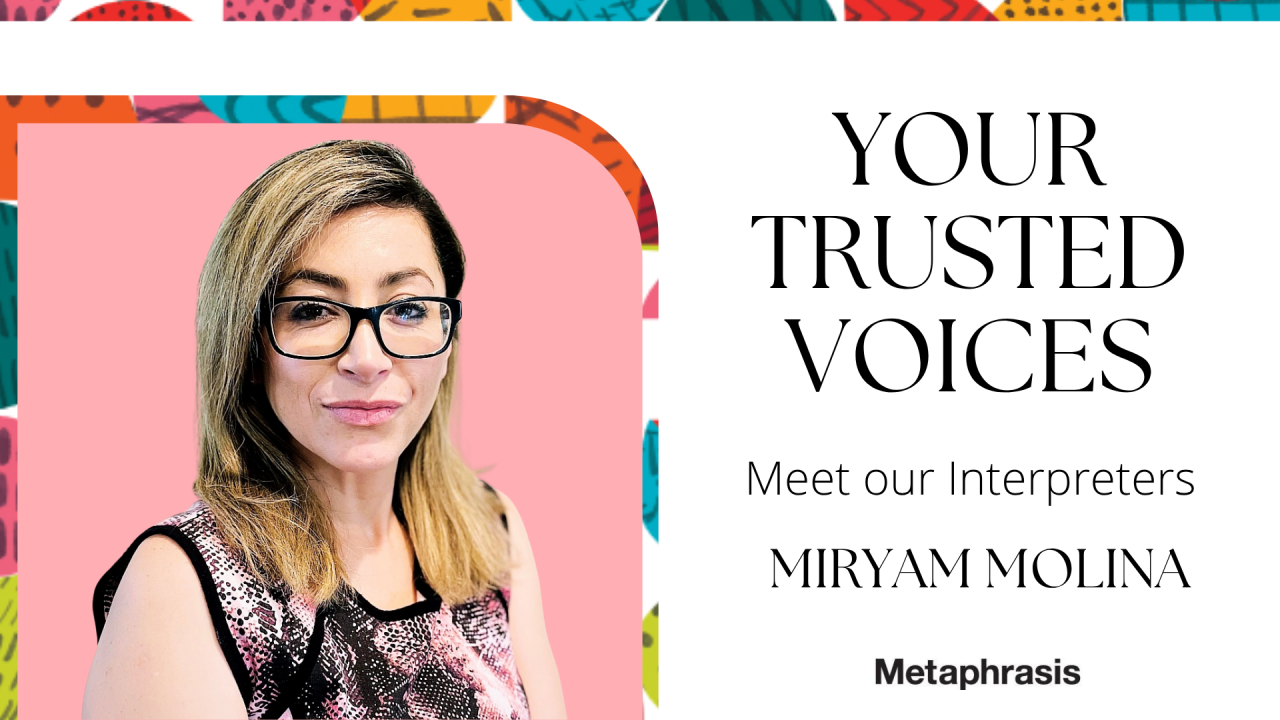
Interpreter Spotlight: Meet Miryam Molina – A Trusted Voice at Metaphrasis
Behind every interpreter is a story. Meet Miryam Molina, one of our standout Spanish interpreters at Metaphrasis. In this article, she opens up about her background, the challenges she faces, and what inspires her to keep showing up to help people feel seen and heard every day.
What led you to become an interpreter?
My journey as an interpreter began in high school when I started helping my mother communicate and understand English-speaking adults and professionals. That early experience sparked my passion for bridging language gaps and supporting meaningful communication.
What kind of training or certifications do you have?
I hold two professional certifications from the University of Georgia, earned between 2018 and 2019: one as a Professional Interpreter in Special Education and another as a Professional Interpreter in Education. Additionally, I am a Qualified Interpreter recognized by the Illinois State Board of Education (ISBE).
Walk us through a typical day—what kinds of environments do you interpret in?
I have the privilege of interpreting in educational settings, primarily working with schools to bridge language barriers during IEP meetings, 504 Plan discussions, annual reviews, nurse documentation updates, and more. Most of the time, I’m able to work from home and provide these services remotely, which allows for flexibility while still maintaining a high level of professionalism. I’ve also had the opportunity to interpret in person when needed. In addition to my work in education, I’ve provided simultaneous interpretation for agencies focused on child development, as well as for insurance-related matters.
What’s the most challenging part of your work?
The most rewarding? One of the most challenging aspects of my work is translating humor and sarcasm, especially when it’s deeply rooted in the Spanish language and culture. Capturing the nuance and intent behind those expressions can be tricky when there’s no direct equivalent in English. On the other hand, the most rewarding part of my job is seeing parents truly understand, communicate, and feel like valued members of the school team—despite the language barrier. It’s incredibly fulfilling to help create a space where both families and educators feel heard and respected, while also fostering cultural awareness and sensitivity on both sides.
Can you share a moment where your interpretation really made a difference for someone?
Throughout the meeting, I focused on delivering the message with care, accuracy, and neutrality. I paid close attention to tone and pace, making sure my voice reflected the emotions behind the words. I maintained appropriate distance and eye contact, ensuring that the focus stayed on the conversation between the parent and the team—not on me.
At the end of the meeting, both the parent and staff expressed how grateful they were. The parent hugged me and thanked me for not only interpreting the words but also conveying the emotions with honesty and transparency. She said it felt like she was truly communicating with the team for the first time.
That experience deeply impacted me. It reminded me that my role goes far beyond simply translating words—I’m the connection, the bridge that helps keep communication whole and human.
What kind of training or certifications do you have?
I hold two professional certifications from the University of Georgia, earned between 2018 and 2019: one as a Professional Interpreter in Special Education and another as a Professional Interpreter in Education. Additionally, I am a Qualified Interpreter recognized by the Illinois State Board of Education (ISBE).
How do you handle emotionally difficult assignments?
When I’m in a difficult meeting or emotionally intense setting, I take a moment to breathe and ground myself so that my emotions don’t interfere with my professionalism or performance. I remind myself that I’m there to serve as a neutral bridge for communication. Detaching emotionally allows me to focus on delivering accurate and respectful interpretation, while still showing compassion through tone and presence.
What’s something people often misunderstand about interpreters?
One common misunderstanding is the assumption that anyone who speaks two languages can interpret. In reality, interpreting requires much more than bilingualism—it takes professional training, specialized skills, a strong command of subject-specific terminology, and the ability to deliver accurate and fluent communication in real time. It’s a complex task that demands both linguistic expertise and cultural understanding to ensure the message is conveyed effectively and respectfully.
What does “language access” mean to you personally?
To me, language access means breaking down barriers so that everyone—regardless of the language they speak—can fully participate, understand, and be understood. It’s about creating equity in communication between individuals, businesses, and organizations. Personally, it means being part of a solution that empowers people to connect, make informed decisions, and feel seen and heard in spaces that might otherwise exclude them.
